World Roundup
September/October 2013


-
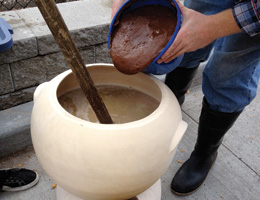 OHIO: The craft-brewing craze has reached into the past for inspiration before—including an ancient Chinese wine, a pre-Olmec chocolate drink, and others. A new attempt, from the Great Lakes Brewing Company in Cleveland, is based on a 5,000-year-old Sumerian poem praising Ninkasi, the goddess of beer. With guidance from Sumerologists and archaeologists, the brewers are using replica clay pots, as well as attempting to reproduce the yeast and barley bread cakes used in the brewing process. So far, their attempts have been dominated by a harsh sourness, so the experiment continues. —Samir S. Patel
OHIO: The craft-brewing craze has reached into the past for inspiration before—including an ancient Chinese wine, a pre-Olmec chocolate drink, and others. A new attempt, from the Great Lakes Brewing Company in Cleveland, is based on a 5,000-year-old Sumerian poem praising Ninkasi, the goddess of beer. With guidance from Sumerologists and archaeologists, the brewers are using replica clay pots, as well as attempting to reproduce the yeast and barley bread cakes used in the brewing process. So far, their attempts have been dominated by a harsh sourness, so the experiment continues. —Samir S. Patel -
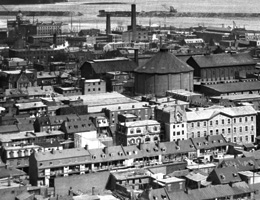 CANADA: Prominent among the changes brought by the Industrial Revolution was the gaslight that brightened streets, factories, and homes, increasing safety, productivity, and leisure time. The gas was extracted from coal and stored in massive holding structures. Construction workers in Montreal have uncovered the brick foundations of one of these gas-holders—there called a “gasometre”—a cylinder some 300 feet in diameter built in 1837. Archaeologists are measuring and mapping the structure to learn more about how it was built. —Samir S. Patel
CANADA: Prominent among the changes brought by the Industrial Revolution was the gaslight that brightened streets, factories, and homes, increasing safety, productivity, and leisure time. The gas was extracted from coal and stored in massive holding structures. Construction workers in Montreal have uncovered the brick foundations of one of these gas-holders—there called a “gasometre”—a cylinder some 300 feet in diameter built in 1837. Archaeologists are measuring and mapping the structure to learn more about how it was built. —Samir S. Patel -
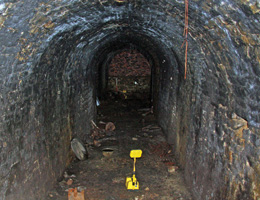 ENGLAND: In 1793, a horse-powered rail line called the Butterly Gangroad was built to connect the limestone quarries at Crich with the Cromford Canal. Archaeologists have opened up part of the line believed to be one of the oldest known railway tunnels in the world. Originally constructed of stone, the tunnel was lined with brick in the 1840s and used as an air raid shelter in World War II. It also hosted a trial of an early steam-powered locomotive in 1813. —Samir S. Patel
ENGLAND: In 1793, a horse-powered rail line called the Butterly Gangroad was built to connect the limestone quarries at Crich with the Cromford Canal. Archaeologists have opened up part of the line believed to be one of the oldest known railway tunnels in the world. Originally constructed of stone, the tunnel was lined with brick in the 1840s and used as an air raid shelter in World War II. It also hosted a trial of an early steam-powered locomotive in 1813. —Samir S. Patel -
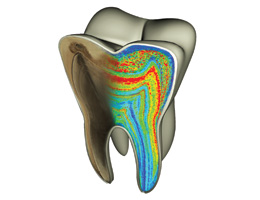 BELGIUM: How long did Neanderthal infants breast-feed? A new study examined the mineral content of teeth of modern humans and macaques and found that elevated levels of barium are a reliable indicator of the ingestion of breast milk. They then applied this test to a fossilized Neanderthal tooth from Belgium, and found that the child was breast-fed exclusively for seven months, followed by seven months of mother’s milk supplemented with other foods. Using the technique on other well-fossilized Neanderthal remains might help show if such abrupt weaning was common among them. —Samir S. Patel
BELGIUM: How long did Neanderthal infants breast-feed? A new study examined the mineral content of teeth of modern humans and macaques and found that elevated levels of barium are a reliable indicator of the ingestion of breast milk. They then applied this test to a fossilized Neanderthal tooth from Belgium, and found that the child was breast-fed exclusively for seven months, followed by seven months of mother’s milk supplemented with other foods. Using the technique on other well-fossilized Neanderthal remains might help show if such abrupt weaning was common among them. —Samir S. Patel -
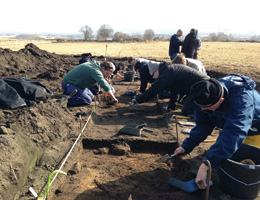 SWEDEN: Detailed analysis of wheat and barley grains from the Stone Age site of Karleby have provided evidence of the use of fertilizer 5,000 years ago. The grains possessed a ratio of nitrogen isotopes suggesting the people of Karleby were supplementing their soil, probably with animal manure. Further analysis will look to see what kinds of weeds grew there—another potential indication of the presence of fertilizer. —Samir S. Patel
SWEDEN: Detailed analysis of wheat and barley grains from the Stone Age site of Karleby have provided evidence of the use of fertilizer 5,000 years ago. The grains possessed a ratio of nitrogen isotopes suggesting the people of Karleby were supplementing their soil, probably with animal manure. Further analysis will look to see what kinds of weeds grew there—another potential indication of the presence of fertilizer. —Samir S. Patel -
 POLAND: No one escaped from the Nazi death camp Sobibor prior to an armed uprising in 1943, but it was not for a lack of trying. Archaeologists recently uncovered evidence of a 32-foot-long tunnel, five feet below the surface, leading from one of the prisoner barracks to beyond the camp’s barbed wire fences. The researchers believe the escape plan was discovered, which likely would have led to the filling in of the tunnel and the execution of everyone involved. —Samir S. Patel
POLAND: No one escaped from the Nazi death camp Sobibor prior to an armed uprising in 1943, but it was not for a lack of trying. Archaeologists recently uncovered evidence of a 32-foot-long tunnel, five feet below the surface, leading from one of the prisoner barracks to beyond the camp’s barbed wire fences. The researchers believe the escape plan was discovered, which likely would have led to the filling in of the tunnel and the execution of everyone involved. —Samir S. Patel -
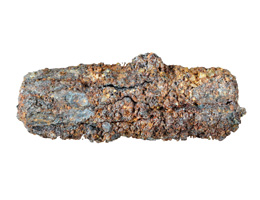 EGYPT: Nine small, cylindrical beads found in two 5,000-year-old grave pits are literally from out of this world. Scientists examined one of the iron beads, first identified in 1911, and found that it is high in nickel and has a crystal structure called a Widmanstätten pattern—both indicative of extraterrestrial origin. Likely from a meteorite, it predates ancient Egyptian iron smelting by at least 3,000 years. Iron seems to have been a rare—and therefore high-status—material in pre-Dynastic Egypt. —Samir S. Patel
EGYPT: Nine small, cylindrical beads found in two 5,000-year-old grave pits are literally from out of this world. Scientists examined one of the iron beads, first identified in 1911, and found that it is high in nickel and has a crystal structure called a Widmanstätten pattern—both indicative of extraterrestrial origin. Likely from a meteorite, it predates ancient Egyptian iron smelting by at least 3,000 years. Iron seems to have been a rare—and therefore high-status—material in pre-Dynastic Egypt. —Samir S. Patel -
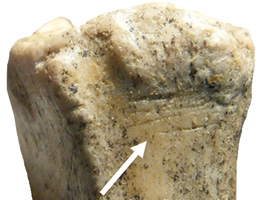 KENYA: Thousands of bone fragments with cut marks and evidence of smashing provide the oldest evidence of consistent meat-eating among humans, going back some 2 million years. While stone tools that could have been used for hunting and butchery, and some isolated animal remains, date back even further, this is the first direct evidence of sustained carnivory. Most of the bones belong to small ungulates such as gazelles, and because they don’t show teeth marks from other animals, they are likely to have been hunted. The hominins also had occasional access to larger, wildebeest-sized animals, which may have been scavenged. —Samir S. Patel
KENYA: Thousands of bone fragments with cut marks and evidence of smashing provide the oldest evidence of consistent meat-eating among humans, going back some 2 million years. While stone tools that could have been used for hunting and butchery, and some isolated animal remains, date back even further, this is the first direct evidence of sustained carnivory. Most of the bones belong to small ungulates such as gazelles, and because they don’t show teeth marks from other animals, they are likely to have been hunted. The hominins also had occasional access to larger, wildebeest-sized animals, which may have been scavenged. —Samir S. Patel -
 MALAWI: Scientists have hypothesized that the eruption of Mount Toba in Indonesia 75,000 years ago caused a global “volcanic winter,” a climate downturn so dramatic that it almost wiped out our species. Sediments from Lake Malawi suggest otherwise. Researchers found ash from the eruption in the sediments, but no changes above the layer—such as a change in the lake’s algal population—that would indicate a major change in climate. If humans were indeed near extinction around that time, the study posits, it wasn’t because of the eruption. —Samir S. Patel
MALAWI: Scientists have hypothesized that the eruption of Mount Toba in Indonesia 75,000 years ago caused a global “volcanic winter,” a climate downturn so dramatic that it almost wiped out our species. Sediments from Lake Malawi suggest otherwise. Researchers found ash from the eruption in the sediments, but no changes above the layer—such as a change in the lake’s algal population—that would indicate a major change in climate. If humans were indeed near extinction around that time, the study posits, it wasn’t because of the eruption. —Samir S. Patel -
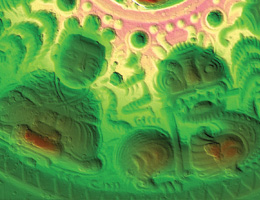 JAPAN: Three-dimensional scanning of a bronze mirror from the early Kofun period, in the 3rd century a.d., has revealed previously unrecognized details in the deities and beasts that decorate it—information that can be used to help settle a heated debate on whether mirrors of this style originated in China or Japan. Scanning is also being used on a much larger scale to study certain Kofun burial mounds, which are known for their distinctive “keyhole” shape, to help reveal how they were constructed. —Samir S. Patel
JAPAN: Three-dimensional scanning of a bronze mirror from the early Kofun period, in the 3rd century a.d., has revealed previously unrecognized details in the deities and beasts that decorate it—information that can be used to help settle a heated debate on whether mirrors of this style originated in China or Japan. Scanning is also being used on a much larger scale to study certain Kofun burial mounds, which are known for their distinctive “keyhole” shape, to help reveal how they were constructed. —Samir S. Patel
Advertisement
IN THIS ISSUE
From the Trenches
No Changeups on the Savannah
Off the Grid
The Last Flying Pencil
Small Skirmish in the War for Freedom
Sifting Through Molehills
City of Red Stone
Animal Offerings of the Aztecs
High-Definition Obsidian
Tomb of the Wari Queens
Golden Sacrifices
Spain's Lost Jewish History
Samson and the Gate of Gaza
French Wine, Italian Vine
Neanderthal Brain Strain
Advertisement

Recent Issues
-
 May/June 2024
May/June 2024
-
 March/April 2024
March/April 2024
-
 January/February 2024
January/February 2024
-
 November/December 2023
November/December 2023
-
 September/October 2023
September/October 2023
-
 July/August 2023
July/August 2023
-
 May/June 2023
May/June 2023
-
 March/April 2023
March/April 2023
-
 January/February 2023
January/February 2023
-
 November/December 2022
November/December 2022
-
 September/October 2022
September/October 2022
-
 July/August 2022
July/August 2022
-
 May/June 2022
May/June 2022
-
 March/April 2022
March/April 2022
-
 January/February 2022
January/February 2022
-
 November/December 2021
November/December 2021
-
 September/October 2021
September/October 2021
-
 July/August 2021
July/August 2021
-
 May/June 2021
May/June 2021
-
 March/April 2021
March/April 2021
-
 January/February 2021
January/February 2021
-
 November/December 2020
November/December 2020
-
 September/October 2020
September/October 2020
-
 July/August 2020
July/August 2020
-
 May/June 2020
May/June 2020
-
 March/April 2020
March/April 2020
-
 January/February 2020
January/February 2020
-
 November/December 2019
November/December 2019
-
 September/October 2019
September/October 2019
-
 July/August 2019
July/August 2019
-
 May/June 2019
May/June 2019
-
 March/April 2019
March/April 2019
-
 January/February 2019
January/February 2019
-
 November/December 2018
November/December 2018
-
 September/October 2018
September/October 2018
-
 July/August 2018
July/August 2018
-
 May/June 2018
May/June 2018
-
 March/April 2018
March/April 2018
-
 January/February 2018
January/February 2018
-
 November/December 2017
November/December 2017
-
 September/October 2017
September/October 2017
-
 July/August 2017
July/August 2017
-
 May/June 2017
May/June 2017
-
 March/April 2017
March/April 2017
-
 January/February 2017
January/February 2017
-
 November/December 2016
November/December 2016
-
 September/October 2016
September/October 2016
-
 July/August 2016
July/August 2016
-
 May/June 2016
May/June 2016
-
 March/April 2016
March/April 2016
-
 January/February 2016
January/February 2016
-
 November/December 2015
November/December 2015
-
 September/October 2015
September/October 2015
-
 July/August 2015
July/August 2015
-
 May/June 2015
May/June 2015
-
 March/April 2015
March/April 2015
-
 January/February 2015
January/February 2015
-
 November/December 2014
November/December 2014
-
 September/October 2014
September/October 2014
-
 July/August 2014
July/August 2014
-
 May/June 2014
May/June 2014
-
 March/April 2014
March/April 2014
-
 January/February 2014
January/February 2014
-
 November/December 2013
November/December 2013
-
 September/October 2013
September/October 2013
-
 July/August 2013
July/August 2013
-
 May/June 2013
May/June 2013
-
 March/April 2013
March/April 2013
-
 January/February 2013
January/February 2013
-
 November/December 2012
November/December 2012
-
 Sep/Oct 2012
Sep/Oct 2012
-
 September/October 2012
September/October 2012
-
 July/August 2012
July/August 2012
-
 May/June 2012
May/June 2012
-
 March/April 2012
March/April 2012
-
 January/February 2012
January/February 2012
-
 November/December 2011
November/December 2011
-
 September/October 2011
September/October 2011
-
 July/August 2011
July/August 2011
-
 May/June 2011
May/June 2011
-
 March/April 2011
March/April 2011
-
 January/February 2011
January/February 2011
Advertisement






